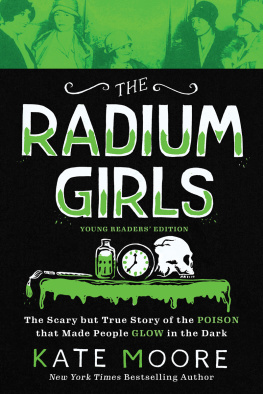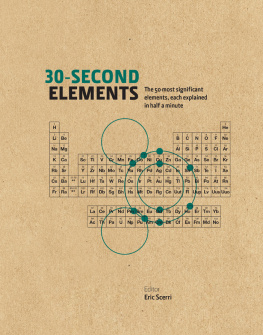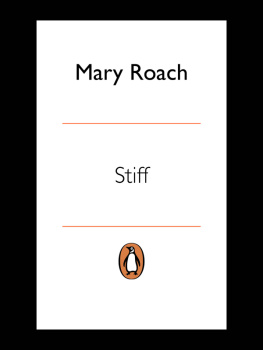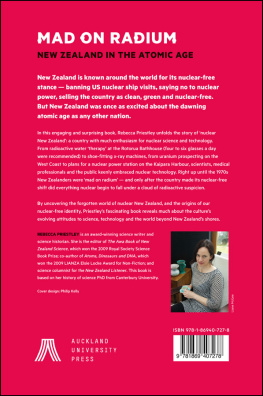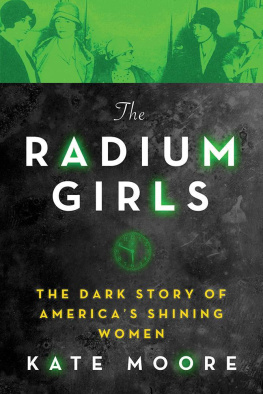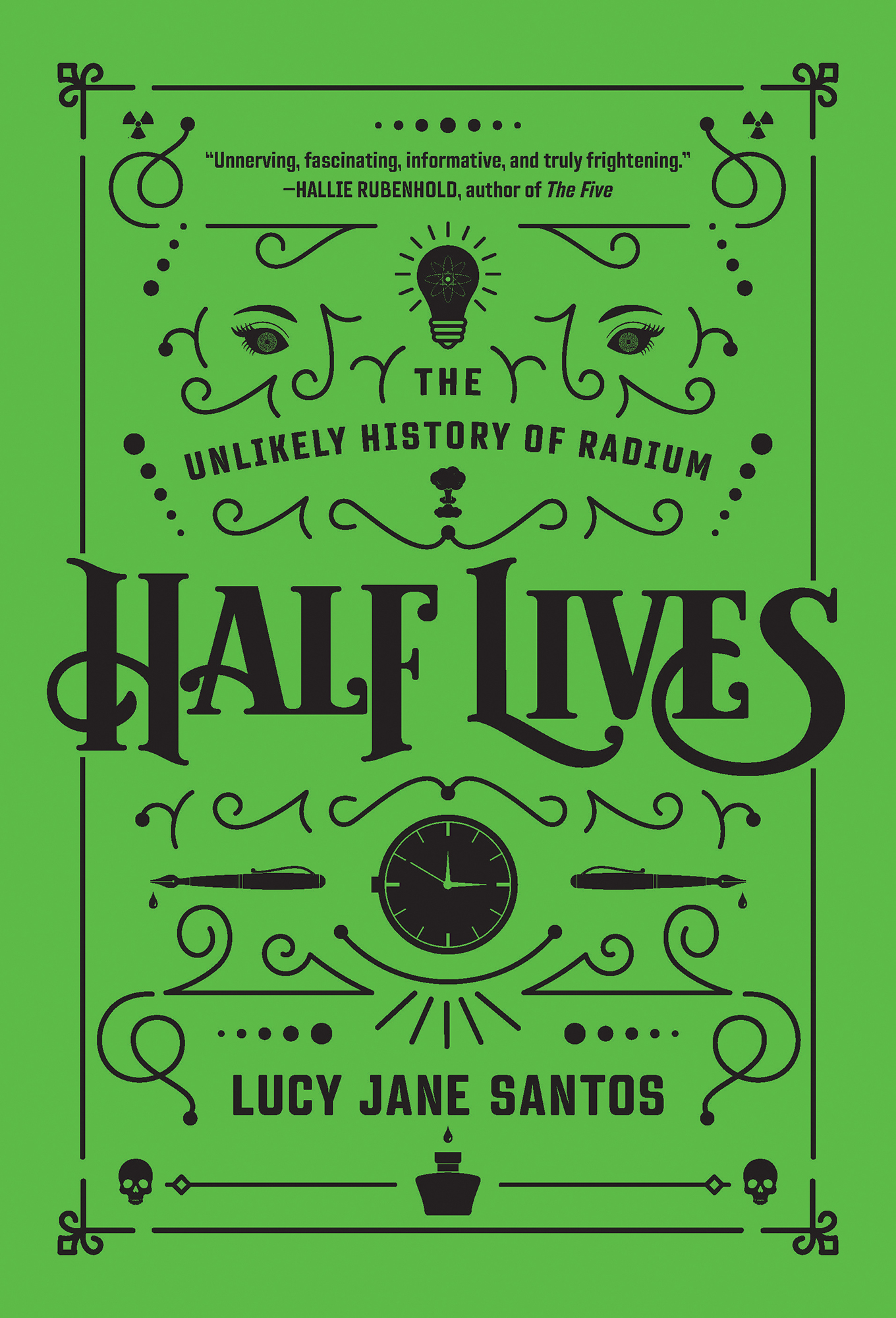Contents
Guide
Unnerving, fascinating, informative, and truly frightening.
HALLIE RUBENHOLD, author of The Five
The Unlikely History of Radium
Half Lives
Lucy Jane Santos
Half Lives shines a light on the shocking history of the worlds toxic love affair with a deadly substance, radium. Unnerving, fascinating, informative and truly frightening.
Hallie Rubenhold, author of The Five
In Half Lives, Lucy Jane Santos transports us back to a time when consumers wondered whether mixing radium into chicken feed might result in eggs that could hard-boil themselves; when diners cheerfully drank radioactive cocktails that glowed in the dark; and when people used toothpaste containing lethal thorium oxide in the pursuit of healthy gums. Santos unpicks fact from fiction and exhibits a masterful grasp of a complex area of science history that is so often mistold. Half Lives is a delightfully disturbing book that reminds us all of the age-old Latin maxim, caveat emptor.
Dr Lindsey Fitzharris, author of The Butchering Art
With verve and vivacity, Lucy Jane Santos conducts her readers on a unique tour of the twentieth centurys most significant scientific discovery. Before the R-word threatened destruction, it offered hope for the future teeth would glow white, cocktails would shine in the dark and cancer would be vanquished. This evocative account puts people and their emotions centre-stage of sciences past.
Dr Patricia Fara
There was a time when radioactivity seemed to promise the future. It was the stuff that twentieth-century dreams were made of, before those dreams turned sour. This marvellous book explores the ways radioactivity stood for a better future, worked its way into money-making schemes of all kinds and offered hope to saints and charlatans. By doing all that and doing it so well it also offers a cautionary tale about the dangers of putting too much faith in simple technological solutions to all our problems.
Prof Iwan Rhys Morus
RADIUM
Have you heard of radium?
Latest, greatest thing on earth;
More than coal the stuff is worth;
An ounce brings a corking sum.
And the things that it can do
Easily would fill a book;
Anything but boss the cook
If the tales we hear are true.
With diseases it has fun;
Cures consumption while you wait
And in manner up to date
Slaughters microbes by the ton.
Wrinkles, patches, freckles, tan.
Cannot in the house remain
If you have a single grain
Of this newest friend of man.
Burglars it will hold at bay,
Strange dogs frighten from the yard,
Always keep the butter hard,
Coax the wayward hens to lay.
Neatly cut the childrens hair,
Wash the windows, scrub the floor,
Run on errands to the store,
Daily scour the silverware.
Firmly, but with grim intent,
Fire agents through the gate,
Keep the family records straight,
Hustle round and pay the rent.
Thirty million, not a sou
Less for one grain, C.O.D.
But its worth it, you can see,
If the tales we hear are true.
Duncan M. Smith, 1904
INTRODUCTION
If you are scared of radioactivity a radiophobe then I am going to start with some bad news: it is everywhere.
This book, for example, is radioactive.
From your first cup of coffee to that refreshing pint of beer in the evening, you are regularly ingesting tiny particles of naturally occurring radioactivity.
If it contains Brazil nuts, your lunch wont be safe either they are a thousand times hotter than other food. Nor should you be consuming avocados, beans, coffee or bananas (a tiny amount of the natural potassium found in these foods is radioactive). And indeed, dont reheat that coffee in your radioactive, thorium-containing microwave if you are implementing a zero-exposure policy.
Naturally occurring radioactive materials (in the form of ores) are present in the Earths crust, the floors and walls of your home, office or school.
You are radioactive.
Our bodies emit radiation because everyone absorbs the radioactive particles that are naturally present in the environment. These substances that trace of uranium, dash of carbon-14, smidgen of potassium or pinch of radium are absorbed by our bodies into our tissues, organs and bones and are constantly replenished by ingestion and inhalation. Night and day you breathe in radioactivity from the air: from the person you slept next to last night and that person who was just that bit too close to you on the train this morning. Even your pets are radioactive.
Radioactivity is naturally so omnipresent in our daily lives that it goes almost unnoticed until the word is spoken in a public place. Then radioactivity suddenly becomes a bright yellow warning sign; an explosion and a poison. Decades of fiction have fed our imaginations with creatures irradiated into monsters, or ordinary mortals given superpowers by a spiders bite, and it has combined with real-life fears: of nuclear power plants, of mushroom clouds and of unimaginable loss and devastation. Artificial radioactivity (the kind made in a laboratory that revolves around nuclear reactors and bombs) for that is what we are all so scared of is the threat of the end of the world.
Of course, we are ALL radiophobes, now.
But this book tells a different story, one of perceptions of radioactivity at a time when it was revered, not feared; when it seemed that everyone was clamouring for more of it, not less.
It was in the late 19th century that Wilhelm Rntgen discovered a previously unknown form of powerful radiation that was invisible to the human eye. This type of ray, which no one (including Rntgen) fully understood at the time, was so mysterious that he simply named it X. In 1896, working from Rntgens findings, Henri Becquerel identified the phenomenon of radioactivity both as a concept and as a force and Marie Skodowska Curie would later give it a name. In 1898, with her husband Pierre, Skodowska Curie identified two new materials, which they named polonium and radium, and which would later confirm the existence of a new type of substance challenging traditional scientific models of what an element should be.
Almost a century of modern chemistry had taught scientists what seemed to them at the time to be certain irrefutable rules. It was almost universally accepted that an element was made out of extremely small particles known as atoms. These atoms were the smallest unit of matter and they were resolutely indivisible (that is, they couldnt be made any smaller). Therefore, it was evident that a pure element was a stable, fixed substance which couldnt be broken down or converted into anything else.
The newly identified radioactive elements uranium, thorium, polonium, radium, and actinium were different. Unlike previously identified elements, they were shown to be capable of change: spontaneously turning into totally different substances without any intervention. The discovery of radioactive elements seriously challenged scientists understanding of the behaviour of elements (which make up most of the universe) and the seemingly irrefutable rules of chemistry which had held sway for so long.
Out of all these radioactive elements, one radium (represented by the symbol Ra) had the most momentous impact of them all. It is not hard to pinpoint exactly why it was this substance (which Marie Skodowska Curie referred to as my beautiful radium) that eventually became the focus both of public fascination and of entrepreneurial zeal. It was not the first known radioactive element (that honour went to uranium); thorium was the preferred material of many early investigators into the properties of radioactivity. Polonium had been identified as an element several months before radium but was found to be too intensively radioactive to be of real use for experimental purposes. Actinium was too chemically similar to other elements, which often confused scientists results. Radium, to quote Goldilocks, was just right: it gave off a steady but intense energy (almost 3,000 times stronger than uranium), its half-life (the average time it takes half of the element to change/decay into a new element) lasted slightly longer than 1,600 years which meant it decayed slowly enough to be easy to use in experiments and once isolated essentially lasted forever. It was rare and hard to produce but that only seemed to add to its desirability.



